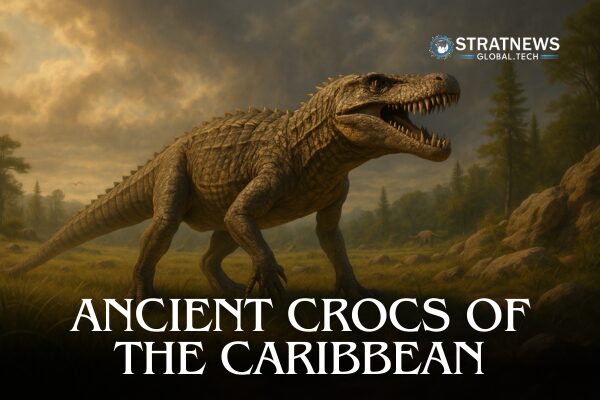Fossils Reveal Fierce Terrestrial Crocodiles Roamed Caribbean Islands
Long after dinosaurs vanished from Earth, mammals rose to dominate. But they were not without rivals. In South America, ancient land-dwelling crocodiles known as sebecids emerged as apex predators. New fossil evidence suggests these powerful predators survived far longer than once believed—thanks to the Caribbean islands acting as a final refuge.
A Predator from a Forgotten Age
Scientists have discovered sebecid fossils in the Dominican Republic dating back 5 to 7 million years. This is significantly more recent than previously known sebecid remains, which were last recorded in Colombia around 10.5 to 12.5 million years ago.
Sebecids were no ordinary reptiles. Unlike today’s semi-aquatic crocodiles, they were fully terrestrial and built for speed. They had long legs and an upright posture, which allowed them to chase prey on land. Their skulls were deep and narrow, similar in shape to those of meat-eating dinosaurs, and their teeth were tall and finely serrated—perfect for slicing through flesh.
The newly found fossils include a tooth and two vertebrae. Researchers confirmed these remains belonged to a sebecid, a surprising find given their extinction elsewhere millions of years earlier.
“These were the kind of predators you’d expect to see in the age of dinosaurs,” said Lazaro Viñola Lopez, lead author and paleontology graduate student at the University of Florida. “It’s incredible they were still alive in the Caribbean so recently.”
A Caribbean Safe Haven
The fossils offer new insights into the Caribbean’s role in preserving ancient species. Viñola Lopez and his team believe sebecids may have reached the islands from South America via temporary land bridges or chains of smaller islands, when sea levels were lower and distances shorter—around 32 to 35 million years ago.
Previous finds, including sebecid-like teeth from Cuba and Puerto Rico dating back 18 and 29 million years respectively, suggest the lineage was once widespread throughout the West Indies.
Jonathan Bloch, study co-author and curator at the Florida Museum of Natural History, said, “It’s amazing to think these fast, meat-eating crocs were still hunting sloths and rodents just a few million years ago.”
Unique Among Crocodilians
Sebecids stand out in crocodile history. While modern crocs thrive in swamps and rivers, sebecids thrived on land. Their teeth and posture were adapted for active hunting, not ambush. Like other crocs, they had bony armour under their skin called scutes, but their body design was much more dynamic.
With competition from terror birds and saber-toothed marsupials, the ecosystems of ancient South America and the Caribbean were rich in fierce land predators. The recent discovery proves that the Caribbean played a key role in preserving species from extinction—offering a glimpse into a unique chapter of evolutionary history.
“This discovery shows how islands can act as biodiversity museums, protecting the last of once-thriving lineages,” Viñola Lopez added.
with inputs from Reuters


